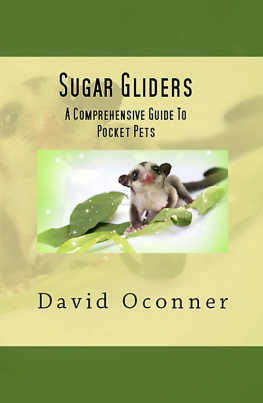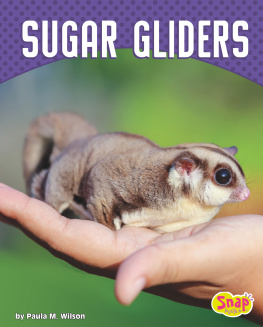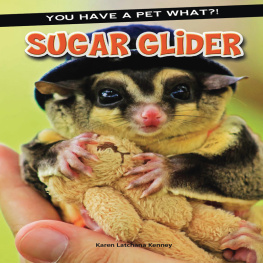SUGAR GLIDERS
A Comprehensive GuideTo
Pocket Pets
By
David Oconner
* * * * *
PUBLISHED BY:
David Oconner atSmashwords
Sugar Gliders
Copyright 2012 byDavid Oconner
ISBN: 9781476354903
Discover other titlesby David Oconner at Smashwords.com
This book is availablein print at most online retailers.
All rightsreserved. No part of this publication may be reproduced ordistributed in any form or by any means, electronic or mechanical,or stored in a database or retrieval system, without prior writtenpermission from the publisher
*****
Table of Contents
SUGARGLIDERS
AComprehensive Guide To
PocketPets
*****
What Are Sugar Gliders?
Sugar glidersare small marsupials that are indigenous to Australia, Tasmania,New Guinea, and several other islands around Indonesia. While sugargliders are now kept as pets and are domesticated, in the wild,sugar gliders dwell in trees and are found in groups of up to 30.In their native tree-dwelling environment, sugar gliders feed oninsects and small vertebrates, as well as the sap of variousspecies of trees like the eucalyptus, acacia, and gum tree. Theirhabit of feeding on both sap from plant life, as well as insectsand the flesh of small vertebrates makes the sugar glider anomnivorous, instead of an herbivore, which is often assumed of thesmall creature.
.

Their diet alsofits well into their habitat because all of their dietary needs canbe met by the trees around them. Additionally, sugar gliders areequipped with a specialized anatomy that makes living in the treetops a breeze for them. Sugar gliders are equipped with spreads ofextra skin that extends from the body to the legs and arms of thesugar glider. This transforms their body into a sort of kite-likeshape, allowing for easy gliding from one area to another. Thisspread of skin is actually known as the patagium, and is classifiedas a thin membrane.
The patagium,as well as the sugar gliders love for sweet sap is how the littlemarsupials got their name, and is also an easy way to remember somequick and important facts about the sugar glider.
In addition tohaving the ability to glide through the air, the sugar glider hasthe ability to steer his general direction by using their tails asrudders. Their tails are relatively long, allowing for excellentnavigation for the 50 meters they are capable of staying in theair.
Otheranatomically unique qualities the sugar glider has are opposablefingers and toes. Each front foot has five different fingers, eachwith sharp claws attached. These sharp claws allow the glider toattach onto a number of surfaces. In the wild, this can mean treesurfaces to prevent from falling. In captivity, gliders may attachto their owners and other surfaces in the house when out toplay.
The back feethave one large opposable toe, two toes that are fused together buteach have separate claws. This particular section of the sugargliders foot is used specifically for grooming.
The sugarglider also has very large eyes, which lend themselves well toseeing in the dark. This is perfect since sugar gliders arenocturnal in nature. Thus, their eyes put them at a great advantagein the dark. Also an advantage to them, is the position of theireyes, which is set widely near the sides of the head. This allowsthe sugar glider to have a wide range of view by which to keep awatch out for predators. This is an extremely important featuresince sugar gliders are so small.
The averageglider measures around six inches in length, which doesnt includetheir lengthy tail which can be just as long as their body. Atadulthood, the sugar glider weighs around 4-6 ounces (depending ongender with males being larger than the female).
Sugar glidershave extremely thick fur that is also very soft. This fur is greywith a black stripe running down the length of the body. This cutelittle stripe lines up perfectly with the spine, starting at thehead and finishing off at the tail that is generally tippedcompletely in black as though it has been dipped in black ink.Sugar gliders also have black markings that appear on the legs,face, and back.

Although sugargliders are small pets, they have a very sizable lifespan. Mostpeople assume that all small pets have a short lifespan, but sugargliders may live from 12 to 15 years when cared for properly. Thisincludes providing the glider with the right company, diet, andcare, all to be discussed in further detail later.
*****
What Are Marsupials?
Marsupials area classification of animals defined by the unique manner in whichthe young are born. Marsupials are best known for raising theiryoung in pouch, but few people realize why exactly this isdone.
Marsupialbabies are born in a highly immature state, unlike mammal babiesthat are delivered at a time when they are able to survive outsideof the womb. Because of the birth of an underdeveloped baby,marsupial babies then continue to develop outside the motherswomb, and attached to the mothers nipple. In many cases, themother has a pouch in which the baby is housed until they are morefully developed and ready to be exposed to the world outside. Sugargliders have this pouch, and thus the mother glider raises thebabies there for up to two and a half months after the babies areborn.
Aside fromsugar gliders, other marsupials include kangaroos, koalas,opossums, wombats, and Tasmanian devils.
*****
Do Sugar Gliders Make Good Pets?
Sugar gliderscan make excellent pets, but this greatly depends on the care theyare given from their owner. Sugar gliders are extremely socialanimals, and as such, they require social interaction. If the ownercannot provide this social interaction on a regular basis, it isbest not to own a sugar glider at all. This also means that sugargliders should be kept in groups of two or more when owned as apet. This allows your glider to have a friend no matter if youreswamped one day and cannot give them as much attention as theyrequire. It should also be noted that no matter how much time youcan devote to your glider, a glider companion can never be replacedby a human one.
You may notexpect it of a pet, but sugar gliders are prone to depression whenhoused alone. So, if youre planning on getting one sugar glider,you really should be planning on getting at least two. With somesugar gliders, aggression and refusal to provide themselves withnourishment may also arise from being housed alone. This latterside effect can be extremely dangerous as it may cause your sugarglider to die of starvation and/or malnourishment.
Getting two ormore sugar gliders doesnt mean that you have to get a male and afemale, especially if you dont want breeding, and arent willingto pay for getting them fixed. All female and/or all male groupsare able to get along. That being said, it should be noted that allmale groups should be taken in all at the same time, and should befrom the same litter. This will eliminate the possibility offighting, and make your life and their life much easier.
As mentionedearlier, the level of care provided by the owner makes a hugedifference in how the sugar glider turns out. Essentially, whetheryour glider will be a great pet, or simply be a resident of thehome. Even with a glider companion, sugar gliders should have amplehuman interaction. The level of interaction you provide willdetermine how friendly the glider turns out to be.
Next page











